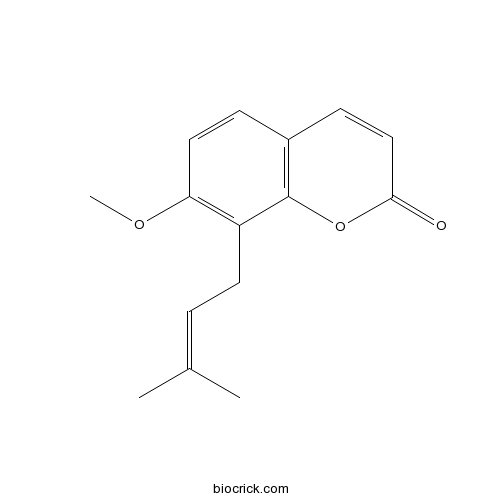InChI=1S/C15H16O3/c1-10(2)4-7-12-13(17-3)8-5-11-6-9-14(16)18-15(11)12/h4-6,8-9H,7H2,1-3H3
Osthol, one major component of cnidii monnieri fructus, has anti-allergic effect.[1]
Osthol can inhibit P-388 D1 cells in vivo and induce apoptosis in HeLa cells in vitro in a time- and concentration-dependent manner, and that osthol is good lead compound for developing antitumor drugs. [2]
Osthol induces a significant increase in acyl-CoA oxidase mRNA expression associated with an increase in carnitine palmitoyl transferase 1a mRNA expression, which suggests the acceleration of beta-oxidation of hepatic fatty acids, at least in part, for the reduction of hepatic triglyceride content in SHRSP; suggests that osthol could be useful for both prevention of atherosclerosis and suppression of hepatic lipid accumulation.[3]
Osthol can stimulate the osteoblastic differentiation of rat calvarial osteoblast cultures by the BMP-2/p38MAPK/Runx-2/osterix pathway and that osthol may be used as an important compound in the development of new antiosteoporosis drugs.[4]
Osthol inhibits fatty acid synthesis and release via PPARα/γ-mediated pathways in 3T3-L1 adipocytes, regulates hepatic PPARα-mediated lipogenic gene expression in alcoholic fatty liver murine.[5,6]
Osthol and curcumin are inhibitors of human Pgp and multidrug efflux pumps of Staphylococcus aureus , reversing the resistance against frontline antibacterial drugs.[7]
[1] Matsuda H, Tomohiro N, Ido Y, et al. Biol Pharm Bull, 2002, 25(6):809-12.
[2] Chou S Y, Hsu C S, Wang K T, et al. Phytother Res Ptr, 2007, 21(3):226–30.
[3] Ogawa H, Sasai N, Kamisako T, et al. J Ethnopharmacol, 2007, 112(1):26-31.
[4] Ming L G, Zhou J, Cheng G Z, et al. Pharmacology, 2011, 88(1-2):33-43.
[5] Zhong W, Shen H, Zhou F, et al. Phytochem Lett, 2014, 8:22-7.
[6] Sun F, Xie M L, Xue J, et al. Phytomed Int J Phytother Phytopharmacol, 2010, 17(9):669-73.
[7] Joshi P, Singh S, Wani A, et al. Med Chem Co, 2014, 5(10):1540-7.
[8] Li M, Qu X, Li Z. China Pharmaceuticals,2006, 15(18):28-9.



